Alaska Fish & Wildlife News
May 2025
Wetland Wanderer: Tracking the Lesser Yellowlegs
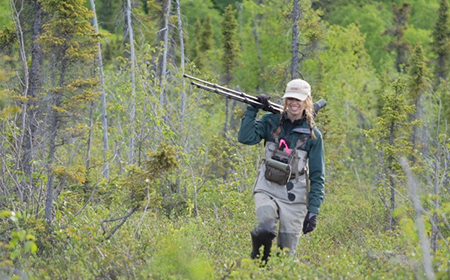
It feels like beachcombing, walking slowly around the dense marsh in Anchorage and peering under each little spruce tree and dwarf birch. I’m not hunting for fossils or Japanese glass balls though, but the far rarer and more elusive nest of the Lesser Yellowlegs.
Lesser Yellowlegs are a small and dainty looking shorebird known for their eponymous bright yellow legs. They often nest in wetlands, which is where I, and two other Fish and Game biologists, find ourselves on this late spring morning. This particular section of wetland is promising because we’ve found nests in the area in previous years. Leads like this are enough to warrant a careful survey of an area in waders, braving mosquitoes, and moose holes in the mud (whose discovery is often accompanied by a shriek and the necessity of a companion to pull you out) in hopes of either flushing a bird from its ground nest or gaining a further clue to its location. These clues most often come in the form of angry parents. Though their lovely, speckled brown and cream plumage works well to camouflage the birds in the wetlands, when it comes to large creatures in their nesting area, Lesser Yellowlegs have all the subtlety of a car alarm. They will surround our team and call from the surrounding treetops in outrage, only ceasing their shrill calls once we have left the area.
Given the amount of time and work it takes to locate just one of these nests, fossil hunters and beach combers alike will recognize the feeling of when my eyes finally fell upon the small nest tucked into the moss with four speckled eggs arranged inward in a circle, triumph tinged with disbelief. I stared at them with my mouth in an “O” 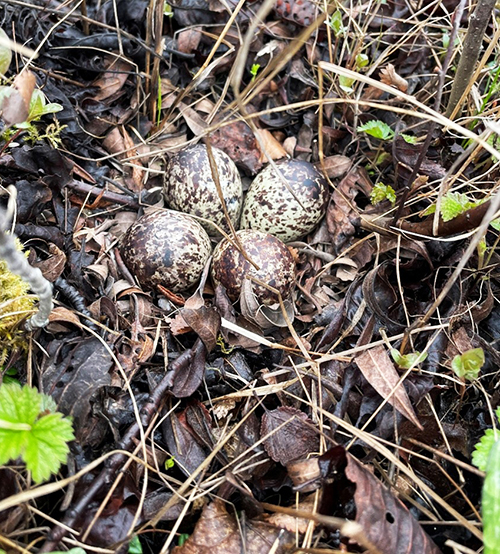 for a moment before frantically waving to the rest of the crew so we could measure the eggs and mark their location as efficiently as possible before leaving the area, letting the parents back on the nest. It was only three weeks later that we returned to this nest site and found it empty, all four chicks having hatched and ventured into the coastal refuge. Finding these nests to measure breeding success, as well as surveying surrounding areas for adult Lesser Yellowlegs, is one of the goals of the ADF&G Lesser Yellowlegs project.
for a moment before frantically waving to the rest of the crew so we could measure the eggs and mark their location as efficiently as possible before leaving the area, letting the parents back on the nest. It was only three weeks later that we returned to this nest site and found it empty, all four chicks having hatched and ventured into the coastal refuge. Finding these nests to measure breeding success, as well as surveying surrounding areas for adult Lesser Yellowlegs, is one of the goals of the ADF&G Lesser Yellowlegs project.
A declining shorebird
Lesser Yellowlegs have many names in multiple languages. They are known as Uviñnuayuuq in Iñupiaq, Petit Chevalier (little knight) in French, and various versions of little yellow-legged sandpiper or lesser yellowshank (Archibebe Patigualdo Chico) in Spanish and Portuguese. This plethora of names reflects the massive range of these small shorebirds, which is thought to be a contributing factor in their population losses.
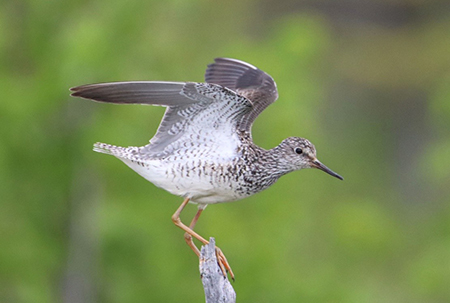
Recent research has revealed a steady decline in most North American bird species since 1970, with a 28% decline in migratory birds, a 37% decline in shorebirds, and a 70-80% decline in Lesser Yellowlegs. While we know Lesser Yellowlegs are likely exposed to multiple threats throughout their range and life cycle, there are questions: where are these threats concentrated? Are they in Alaska? The wintering habitat? Migration route? Where exactly do Alaskan Lesser Yellowlegs go once they leave the state?
The Lesser Yellowlegs Project
The Alaska Lesser Yellowlegs project was initiated in 2018, building on work and surveys done by Lee Tibbitts in the 1990’s. The first goal of the project was to track Lesser Yellowlegs with GPS tags to find out where they went when they left their northern breeding grounds. This research revealed new information on where the birds spend their time out of the state and what possible threats in these new areas could be contributing to their decline. Alaskan birds were shown to fly through Canada, down into the Prairie Pothole region, then through Central America and on to the Pampas region of Argentina. Today, the Lesser Yellowlegs Working Group reflects this range with 33 members across eight countries, working on 14 different research and conservation projects to address threats to the population. These threats include wetland drying from changing climates across Alaska and Canada, intensive farming and pesticide use in the Dakotas and Central and South America, along with shoreline hardening (development that removes shoreline habitat) on the Atlantic coast, and unsustainable harvest in the Caribbean. Current projects are studying the effects of pesticides on Lesser Yellowlegs in North Dakota, working with American farmers to create more habitat during migration, and offering sustainable hunter training and refuge formation in the Caribbean.
Our projects in the breeding habitat of the Lesser Yellowlegs in Canada, Anchorage, and Fairbanks focus on surveys of the birds, tracking their survival, breeding success, and banding new birds. To accomplish this, the Anchorage crew and I start out into the often ice-covered wetlands in mid-May every year. We are on the lookout 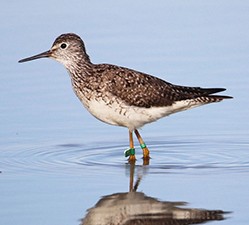 for birds with green leg flags (right) to aid in the survival study, surveying bird numbers, and searching for nests. By the time most Lesser Yellowlegs’ nests are hatching, the ice on the lakes has melted into full lily pads with yellow flowers, the woods are full of chicks on the move, the leaves on the birch and alder are so green they almost glow, pushky has grown to shoulder-height, and bug nets are required.
for birds with green leg flags (right) to aid in the survival study, surveying bird numbers, and searching for nests. By the time most Lesser Yellowlegs’ nests are hatching, the ice on the lakes has melted into full lily pads with yellow flowers, the woods are full of chicks on the move, the leaves on the birch and alder are so green they almost glow, pushky has grown to shoulder-height, and bug nets are required.
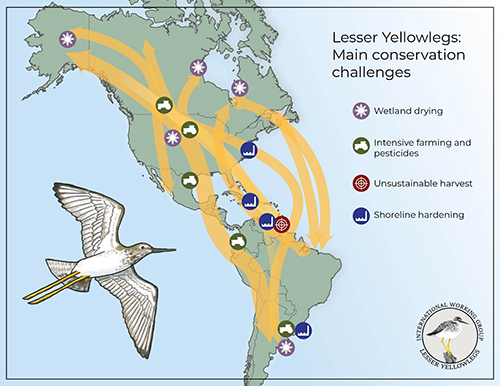
Even though I’ve grown up here I’m still constantly taken aback by the beautiful landscapes and wildlife I can find in the city. I’ve had a flock of thirty Sandhill Cranes fly just over my head across the vast Coastal Refuge, found delicate sundews in the mud of Bicentennial Park, watched twin moose calves take their first steps with Fire Island in the distance, and been surrounded by jewel-blue Tree Swallows shining in the sunlight through the bleached tree trunks of the ghost forest.
We need to handle the Yellowlegs’ eggs to measure when they will hatch and we need to capture, band, and release adults to continue our survival study. Holding a Lesser Yellowlegs in your hands can feel surreal because 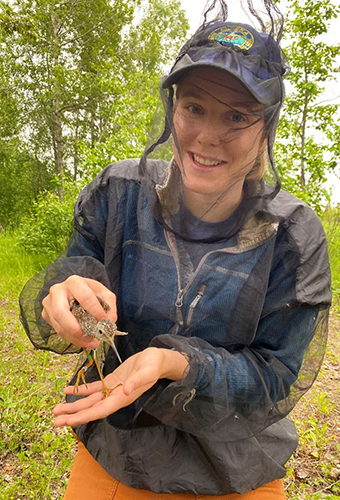 the bird that weighs less than a deck of cards could have travelled some 8,000 miles from South America to lay its eggs in the marshlands of Anchorage. The eggs feel even more precious to hold, small and speckled, built from the resources of another continent, and one day capable of crossing oceans as a young bird. The fieldwork here makes it evident how Alaska functions as a breeding ground and haven of high-quality habitat for incalculable rivers of biomass in the form of migratory birds and mammals. I feel lucky to live here, to experience what our wild spaces offer, and to be a part of conserving them for the future.
the bird that weighs less than a deck of cards could have travelled some 8,000 miles from South America to lay its eggs in the marshlands of Anchorage. The eggs feel even more precious to hold, small and speckled, built from the resources of another continent, and one day capable of crossing oceans as a young bird. The fieldwork here makes it evident how Alaska functions as a breeding ground and haven of high-quality habitat for incalculable rivers of biomass in the form of migratory birds and mammals. I feel lucky to live here, to experience what our wild spaces offer, and to be a part of conserving them for the future.
Help us find banded birds
Banded Lesser Yellowlegs can be found in Fairbanks out by Moose Creek and Eielson Air Force Base, as well as Anchorage and JBER. Photographing the flags on these birds to read the code (often two letters, numbers, or a combination) is one of the most important data points we can use. If you are visiting or birding at lakes and wetlands around these areas, please send us any flag codes or photos you are able to get. We will need the location or GPS points of the banded bird, the time and date seen, as well as the flag code, and which leg the flag is on if possible. If you are able to get any of this information, please email it to yellowtringa@gmail.com.
How to conserve shorebirds
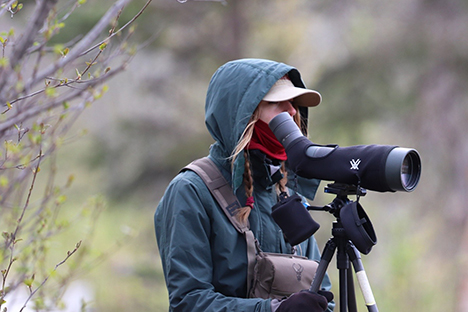
While the decline of these shorebirds is still being understood, there are small actions anyone can take that can help to conserve the Lesser Yellowlegs and other local bird species:
- Support organic food to protect the Lesser Yellowlegs’ food supply.
- During chick season in June, watch roads for vulnerable chicks making their way to foraging areas
- Keep your cat inside. Free-roaming cats are some of the biggest predators to birds, killing some 2-3 billion birds in the U.S. every year. Keeping cats inside protects both the cat’s safety, and that of birds and especially flightless chicks.
- Leash dogs near wetland areas and beaches. Dogs chasing shorebirds causes them to waste valuable energy fleeing during the most energy critical parts of their lives, migration and breeding. Loose dogs can also kill birds and chicks, or trample nests.
- Reduce window collisions to help perching birds and raptors.
- Support bird-friendly coffee, chocolate, and syrup to preserve wintering habitat for Alaska birds.
- Watch birds and share what you see!
Arin Underwood is a wildlife biologist with ADF&G’s Threatened, Endangered, and Diversity Program. She works with citizen science projects and supports research on birds and small mammals in Southcentral Alaska.
Subscribe to be notified about new issues
Receive a monthly notice about new issues and articles.
